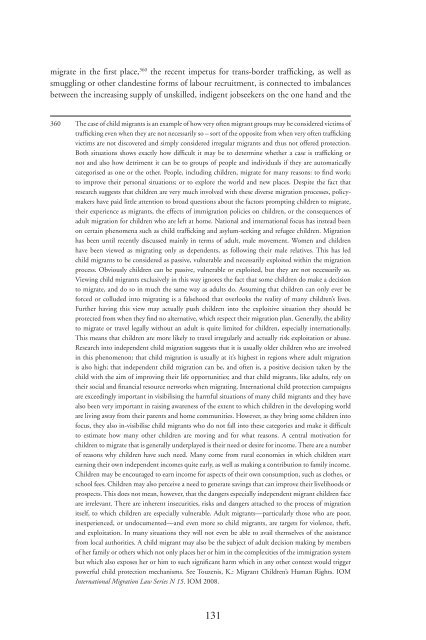Trafficking in human beings: human rights and ... - unesdoc - Unesco
Trafficking in human beings: human rights and ... - unesdoc - Unesco
Trafficking in human beings: human rights and ... - unesdoc - Unesco
Create successful ePaper yourself
Turn your PDF publications into a flip-book with our unique Google optimized e-Paper software.
migrate <strong>in</strong> the fi rst place, 360 the recent impetus for trans-border traffi ck<strong>in</strong>g, as well as<br />
smuggl<strong>in</strong>g or other cl<strong>and</strong>est<strong>in</strong>e forms of labour recruitment, is connected to imbalances<br />
between the <strong>in</strong>creas<strong>in</strong>g supply of unskilled, <strong>in</strong>digent jobseekers on the one h<strong>and</strong> <strong>and</strong> the<br />
360 The case of child migrants is an example of how very often migrant groups may be considered victims of<br />
traffi ck<strong>in</strong>g even when they are not necessarily so – sort of the opposite from when very often traffi ck<strong>in</strong>g<br />
victims are not discovered <strong>and</strong> simply considered irregular migrants <strong>and</strong> thus not offered protection.<br />
Both situations shows exactly how diffi cult it may be to determ<strong>in</strong>e whether a case is traffi ck<strong>in</strong>g or<br />
not <strong>and</strong> also how detriment it can be to groups of people <strong>and</strong> <strong>in</strong>dividuals if they are automatically<br />
categorised as one or the other. People, <strong>in</strong>clud<strong>in</strong>g children, migrate for many reasons: to fi nd work;<br />
to improve their personal situations; or to explore the world <strong>and</strong> new places. Despite the fact that<br />
research suggests that children are very much <strong>in</strong>volved with these diverse migration processes, policymakers<br />
have paid little attention to broad questions about the factors prompt<strong>in</strong>g children to migrate,<br />
their experience as migrants, the effects of immigration policies on children, or the consequences of<br />
adult migration for children who are left at home. National <strong>and</strong> <strong>in</strong>ternational focus has <strong>in</strong>stead been<br />
on certa<strong>in</strong> phenomena such as child traffi ck<strong>in</strong>g <strong>and</strong> asylum-seek<strong>in</strong>g <strong>and</strong> refugee children. Migration<br />
has been until recently discussed ma<strong>in</strong>ly <strong>in</strong> terms of adult, male movement. Women <strong>and</strong> children<br />
have been viewed as migrat<strong>in</strong>g only as dependents, as follow<strong>in</strong>g their male relatives. This has led<br />
child migrants to be considered as passive, vulnerable <strong>and</strong> necessarily exploited with<strong>in</strong> the migration<br />
process. Obviously children can be passive, vulnerable or exploited, but they are not necessarily so.<br />
View<strong>in</strong>g child migrants exclusively <strong>in</strong> this way ignores the fact that some children do make a decision<br />
to migrate, <strong>and</strong> do so <strong>in</strong> much the same way as adults do. Assum<strong>in</strong>g that children can only ever be<br />
forced or colluded <strong>in</strong>to migrat<strong>in</strong>g is a falsehood that overlooks the reality of many children’s lives.<br />
Further hav<strong>in</strong>g this view may actually push children <strong>in</strong>to the exploitive situation they should be<br />
protected from when they fi nd no alternative, which respect their migration plan. Generally, the ability<br />
to migrate or travel legally without an adult is quite limited for children, especially <strong>in</strong>ternationally.<br />
This means that children are more likely to travel irregularly <strong>and</strong> actually risk exploitation or abuse.<br />
Research <strong>in</strong>to <strong>in</strong>dependent child migration suggests that it is usually older children who are <strong>in</strong>volved<br />
<strong>in</strong> this phenomenon; that child migration is usually at it’s highest <strong>in</strong> regions where adult migration<br />
is also high; that <strong>in</strong>dependent child migration can be, <strong>and</strong> often is, a positive decision taken by the<br />
child with the aim of improv<strong>in</strong>g their life opportunities; <strong>and</strong> that child migrants, like adults, rely on<br />
their social <strong>and</strong> fi nancial resource networks when migrat<strong>in</strong>g. International child protection campaigns<br />
are exceed<strong>in</strong>gly important <strong>in</strong> visibilis<strong>in</strong>g the harmful situations of many child migrants <strong>and</strong> they have<br />
also been very important <strong>in</strong> rais<strong>in</strong>g awareness of the extent to which children <strong>in</strong> the develop<strong>in</strong>g world<br />
are liv<strong>in</strong>g away from their parents <strong>and</strong> home communities. However, as they br<strong>in</strong>g some children <strong>in</strong>to<br />
focus, they also <strong>in</strong>-visibilise child migrants who do not fall <strong>in</strong>to these categories <strong>and</strong> make it diffi cult<br />
to estimate how many other children are mov<strong>in</strong>g <strong>and</strong> for what reasons. A central motivation for<br />
children to migrate that is generally underplayed is their need or desire for <strong>in</strong>come. There are a number<br />
of reasons why children have such need. Many come from rural economies <strong>in</strong> which children start<br />
earn<strong>in</strong>g their own <strong>in</strong>dependent <strong>in</strong>comes quite early, as well as mak<strong>in</strong>g a contribution to family <strong>in</strong>come.<br />
Children may be encouraged to earn <strong>in</strong>come for aspects of their own consumption, such as clothes, or<br />
school fees. Children may also perceive a need to generate sav<strong>in</strong>gs that can improve their livelihoods or<br />
prospects. This does not mean, however, that the dangers especially <strong>in</strong>dependent migrant children face<br />
are irrelevant. There are <strong>in</strong>herent <strong>in</strong>securities, risks <strong>and</strong> dangers attached to the process of migration<br />
itself, to which children are especially vulnerable. Adult migrants—particularly those who are poor,<br />
<strong>in</strong>experienced, or undocumented—<strong>and</strong> even more so child migrants, are targets for violence, theft,<br />
<strong>and</strong> exploitation. In many situations they will not even be able to avail themselves of the assistance<br />
from local authorities. A child migrant may also be the subject of adult decision mak<strong>in</strong>g by members<br />
of her family or others which not only places her or him <strong>in</strong> the complexities of the immigration system<br />
but which also exposes her or him to such signifi cant harm which <strong>in</strong> any other context would trigger<br />
powerful child protection mechanisms. See Touzenis, K.: Migrant Children’s Human Rights. IOM<br />
International Migration Law Series N 15. IOM 2008.<br />
131

















